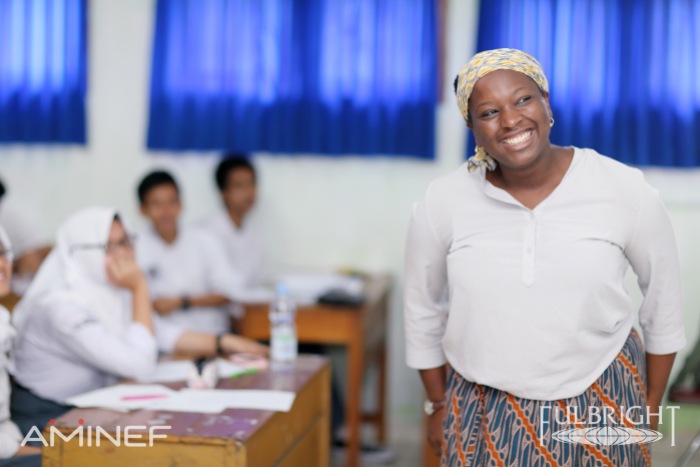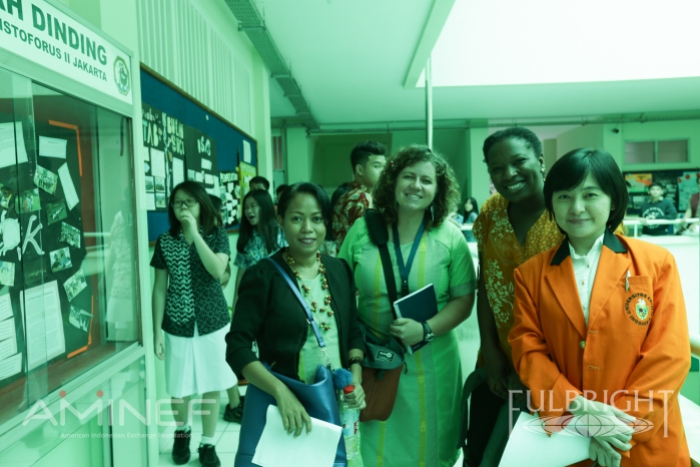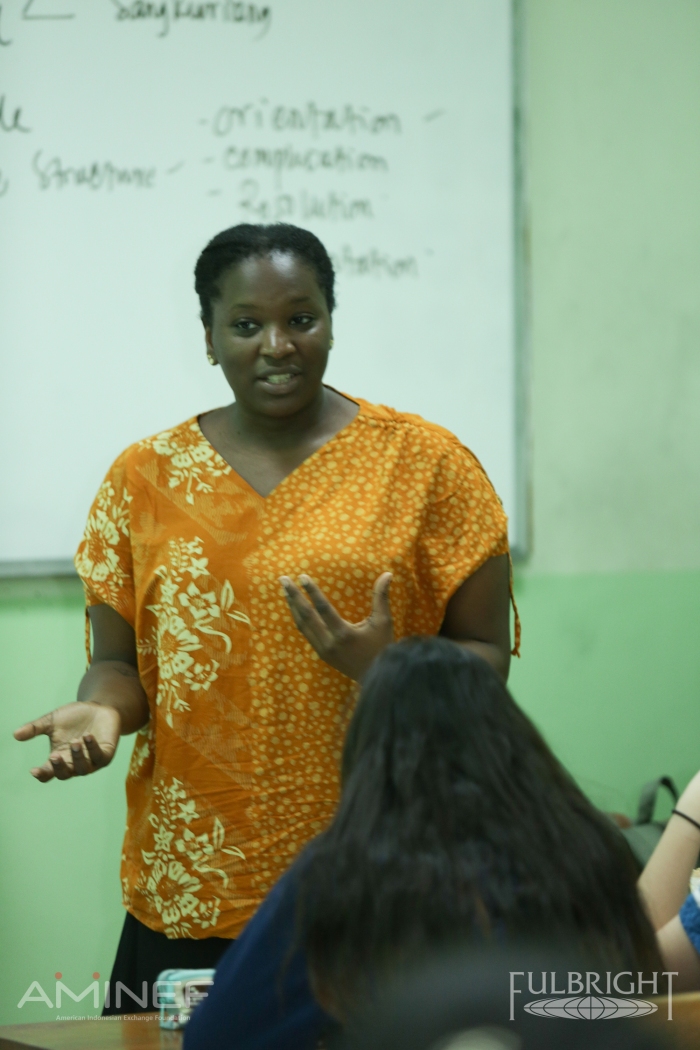– by Kayla Stewart –
This spring, Fulbridge asked ETAs to write about the theme of diversity– “the condition or quality of being diverse, different, or varied; difference, unlikeness” – in their grant experiences. This month, ETAs from around the world share how the grant year has changed their perspectives on diversity. Read the full series here.
This piece was written by Kayla Stewart, 2016-17 ETA in Indonesia.
Recently, I went to the movies in Semarang with a friend. We noticed that all of the American films that have been shown in Indonesia during our grant have featured mostly white cast members. The films released here have been varied; fantasy and sci-fi, comedy and horror. Yet, despite making waves in the U.S. and across the globe – both award-winning wise and financially – “Hidden Figures”, “Moonlight”, and “Fences” somehow failed to make an appearance at any theatre.
Then, Get Out, a comical horror movie that discuss the current racial climate in America, made an appearance. The highest-grossing debut from a writer-director with an original screenplay had actually made it to Indonesia. Naturally, my sitemate and I made plans to see it that weekend.
It was out of theaters before the end of the week.
Frustrated that it was already gone, a fellow *ETA mentioned that due to the references that may only be understood by Americans, maybe Indonesians just couldn’t connect to the film.
I thought back to some of my own favorite films throughout life. Inception, The Holiday, Titanic, the entire Harry Potter series; all movies that depict countries different than my own, experiences different than my own, and worlds that aren’t even real. And, of course, they also feature actors who are white, blonde or brown-haired, and have virtually none of the same experiences I had growing up.
Yet, despite my differences in upbringing and experience, somehow, I found a way to connect to the characters in these stories and many others. Just like many Indonesians have been able to connect to movies like Doctor Strange, Fantastic Beasts and Where to Find Them, Beauty and the Beast, and Baby. Although these movies featured not one Indonesian, Indonesians flocked to see them. Yet, Get Out couldn’t even garner enough viewers to stay in theaters for more than a week.
Thanks to a whitewashing of media, limited imagery of what America actually looks like, and an intense lack of understanding or desire to understand or see Black Americans, a number one movie lasted less than a week in theaters in one of the most populated cities in Indonesia. Unfortunately, this ambivalence to blackness or anything not white about America is a pervasive problem that has made my experience in Indonesia a trying one.

Kayla teaches at a vocational high school in Semarang.
I was in Indonesia for one week and had already been asked multiple times if I wanted whitening cream. I didn’t even know my address yet, and people were already trying to turn me into Scarlett Johansson.
But this desire to erase and flat-out mock my blackness was just the beginning of an eye-opening – often frustrating –experience. There’s a particular cruelty in racial discrimination that you don’t quite understand until you experience it. Teaching in a country where many folks that haven’t been exposed to many black people in person has given me several unwanted doses of what this feels like.
My knowledge of anti-blackness/obsession with whiteness wasn’t unknown prior to my coming to Indonesia. Message boards warned me of the racism I’d face. My parents worried about my decision to spend a year here, especially coming from my diverse bubble of Houston, TX. All of my schools, including college, were extremely diverse. My neighborhood, formerly mostly white when my parents first moved there in the 70s, was mainly black, Asian, and white during my K-12 years. My friends throughout childhood and to this day had ethnic roots that stretched to almost every corner of the world. While I certainly experienced racism, mostly systemic, and microaggressions as I got older, I simply didn’t grow up with the blatant hatred and disgust that my parents did during their 1960s upbringing in segregated Baton Rouge, LA.
So imagine going from living in a world where people are fired people if they inflict racist practices in the workplace, then coming to a place and not being served for 15 minutes in a restaurant, watching others walk in and get served immediately.
When I tried to explain my experiences to a non-person of color at home, they tried to rationalized my frustrations with Indonesians by accusing me of mistaking curiosity with racism. This was the same day that I was video recorded by a 5-year-old sent over by their coward parent, while my Asian American sitemate who was sitting across from me was able to attend to his work on his laptop unbothered. It was also the same day that a group of teenage boys saw me, got the attention on their other friends to look at me, pointed at me unapologetically, and started laughing together.

Kayla has taught at several schools in Indonesia.
There’s a difference between curiosity and ignorance. I’ve experienced the latter for the majority of my grant.
While my white colleagues are often called beautiful and exalted, I haven’t heard the word beautiful to describe me once. When I first arrived in Semarang, I would occasionally spend time with white ETAs. I noticed that all of the stories I’d heard about Indonesians, their friendlessness, their excitement to make you a part of their community, and the requests for numerous selfies, was an experience (and not always a good one) that was often limited to white ETAs. Most people outside of school communities didn’t ask me for selfies. They took photos of me “discreetly” without my consent (failingly, as I can see them tilting their huge Androids directly at my face), or would send their children to come and record me and take photos directly in my face. Again, without my consent. In fact, the few times I’ve actually been “asked” to take a photo outside of my school community has been when I was with a group of white or Asian American ETAs and am thus required to be in the photo.
I wasn’t looking to be in a plethora of selfies with people I don’t know. What disturbs me is that my value as an American, as a woman, and as a human with a variety of experiences is decreased because my skin is a dark, chocolatey brown. My intellect is overlooked, my beauty isn’t recognized, and my validity as a cultural ambassador depends on me working two to three times as hard to to prove that not only do I deserve this Fulbright grant, I deserve to be seen as fully human, with feelings and emotions and boundaries and dreams.
In an effort to survive, I initially found myself trying to rationalize the overt racism. Perhaps it’s just curiosity, I told myself, and perhaps I’m making a big deal out of nothing. I ignored the stares when I walked to the laundry and the groups of people that would gather to gawk at a real, live African American. I tried to block out the children that screamed when I walked to a *warung with a smile on my face. I tried to reason with myself when I would try to buy a coconut from a market from three different sellers that wouldn’t acknowledge my presence. I tried to justify the warung owner that would scowl when I would come in to buy some *tahu and *nasi, as if me, a paying customer, was taking up too much space in his warung that was currently serving four people. I tried to block out the voices when I overheard someone ask, “She’s able to be in the program like ‘the other’ students selected?” These blatant displays of disrespect and racism should be attributed to curiosity, fear of the unknown, and results of the entrenched white supremacy from colonialism justifies being made to feel insignificant and ostracized, right?
Then I thought back to my own experiences of coming in contact with someone who was “different” than I was. I thought of the first time I had white classmates in preschool and noticed how different our hair wasn’t the same. I thought of *Ricky, the kid in elementary class who had cancer, and thus, no hair. I thought talking to the first transgender person I’d ever met at my church when I was 10 years old.
All of these times, I was a child and, thus, somewhat able to get away with ignorance and ill-informed comments or reactions. And certainly, I was curious, but I was never cruel. I never saw these people as less human, or less worthy. I knew we were different, but I wanted to know more about the ways in which we were similar. Their differences didn’t bother me or make me give them funny looks. They made me appreciate just how different and diverse our world really is. I never acknowledged what made us different because I knew that humans aren’t a monolith.
It’s this realization that made me especially disturbed with the reactions to my existence. I, along with I’d imagine most of my cohort, all have a similar understanding of the above concept – that our differences aren’t cause to make someone feel separate. That humans look and feel in different ways, and that should be a cause for celebration, not ill-informed reactions.
I began to doubt the curiosity factor when I understood how heavily Indonesians believe in social media. This isn’t a country that’s exempt from the reality from the rest of the world. While American media certainly has a ways to go in expressing diverse and accurate representations of Americans, African Americans are literally everywhere. We’re artists, politicians, teachers, and historians. We make up a large part of American history, and we also use social media at rates untouched by white Americans.
So the excuse of people never seeing an African American doesn’t cut it for me. Not only because we’re real and visible, but also because we’re simply human.

Kayla has often found ways to incorporate conversations about race and identity in her classroom.
It would be disingenuous to say that all of my experiences have been negative. My students have been the shining glory of living in this country. My school community – as well as my sitemate’s – has been respectful, helpful, and welcoming. The university students here have certainly given me a new and more nuanced understanding of what it means to be a true friend. It’s this community that I’ve been able to create that has made this experience wonderful. But your experience should not vary so vastly due your skin color based on how well people know you. We should be at a point in history where no one is made to feel unwanted or less human. Living in Indonesia has certainly been wonderful, but I had to learn lessons about humanity that I shouldn’t have to learn in 2017.
This lack of appreciation for darkness isn’t limited to me and other black visitors. In conversations with young Indonesians, I’ve learned that lighter is better for them, too. Lightness is revered, and darkness is seen as a problem that needs to be solved.
Indonesia is an extremely diverse country, full of different ethnic groups and languages spoken across the archipelago. In a similar way to America, it has grappled with how to best appreciate its diversity and create a sense of national pride. While my time in Indonesia is limited, it is my hope that this incredible country begins to not only appreciate diversity, but appreciate and accept skin color as one of the many parts of identity that makes a person whole.
*Ricky’s name was changed out of respect to the child.
*Nasi is rice and tahu is tofu
*ETA stands for English Teaching Assistant
*warungs are small, often family-owned, restaurants in Indonesia
Kayla Stewart is currently teaching at SMK Negeri Jawa Tengah in Semarang. She was inspired to teach English in Indonesia because she was interested in learning more about the role of media in the country and how diversity in the nation affects intercultural relationships. She studied journalism, Global International Studies, and African American Studies at the University of Houston. Kayla loves reading, running, watching basketball, traveling, fighting white supremacy, and checking out new coffee shops around the world.
This blog post was originally published on Indonesiaful.
